|
This section contains 686 words (approx. 2 pages at 400 words per page) |

|
Chapter 4, The Infinite God of Nothing Summary and Analysis
Zero and infinity were popular during the Renaissance. The papacy did not initially see the danger. However, the church eventually retreated into Aristotelian doctrine. Yet zero had already taken hold. The proofs of God's existence fell apart. God could now be found in the void.
Zero would become necessary for Renaissance art through the work of Italian architect Filippo Brunelleschi, who created a realistic painting through the use of a vanishing point. Before the vanishing point, paintings were notoriously flat. The vanishing point was made possible by zero because the painting could approach 'nothing.' Filippo's painting of a famous Florentine building called the Baptistery, had a vanishing point. Zero allowed the representation of three-dimensions.
Aristotle had also maintained that the Earth was unique, at the center of the universe and...
(read more from the Chapter 4, The Infinite God of Nothing Summary)
|
This section contains 686 words (approx. 2 pages at 400 words per page) |

|




